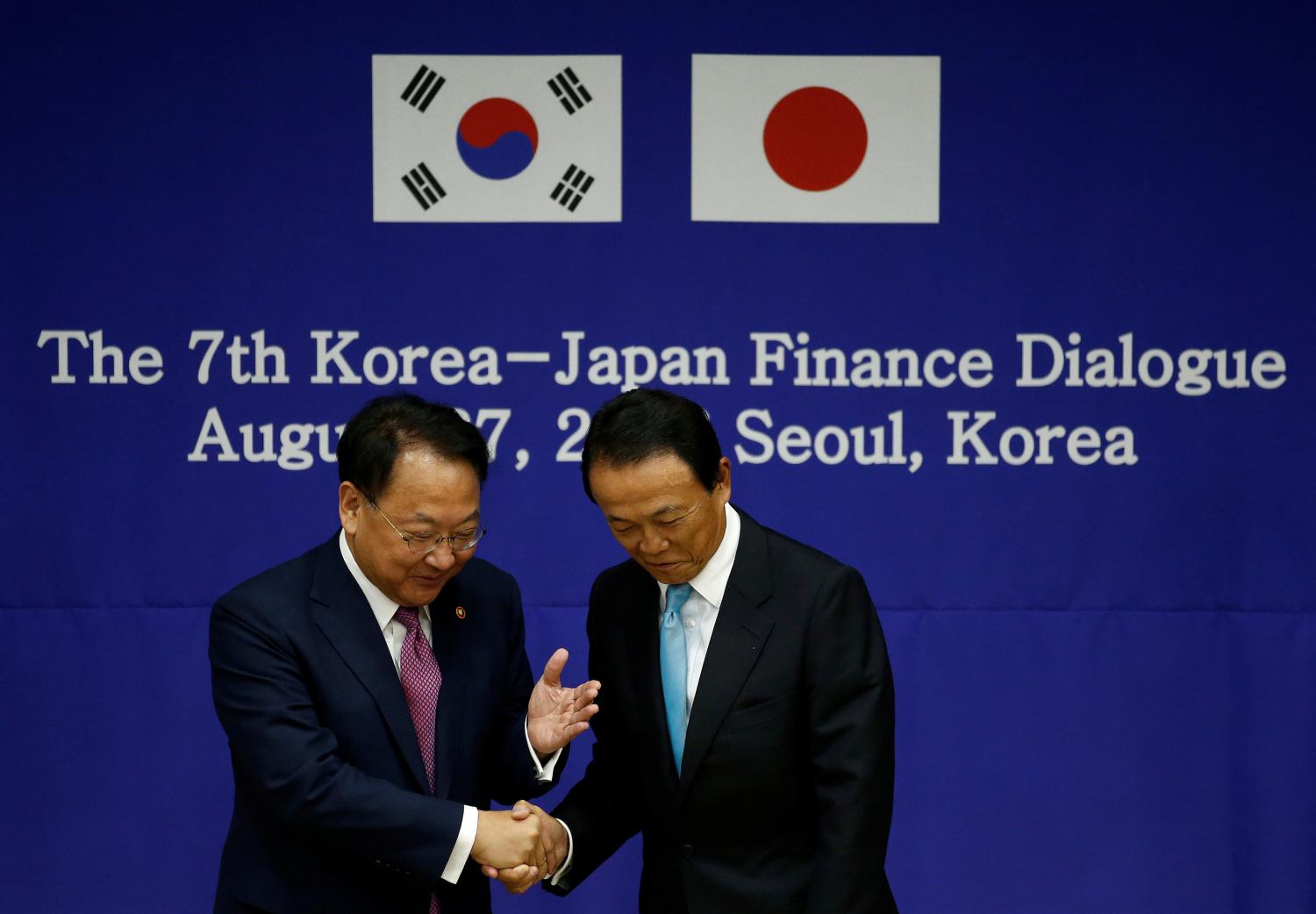For a region that hasn’t seen a real shooting war in almost 40 years, East Asia is surprisingly tense. Threats abound, generating anxiety and bad feeling. China continues to flex its economic and military muscles and North Korea vows not to give up its growing nuclear weapons arsenal.[1]
It is at least fortunate that most of the legacies of past conflict in East Asia have faded. The war in Southeast Asia is long over. North Korea, still technically at war with South Korea and the United Nations Command, has limited itself to threats and minor skirmishes since the Korean War armistice was signed in 1953. Japan and the United States have been close allies for over half a century, although Japan’s geographic neighbors have not forgotten or forgiven Japan’s aggression before and during World War II, especially with recent talk of expanding Japan’s defense capabilities. And yet, under the peaceful surface, there is widespread unease and a real potential for future conflict—conflict that would inevitably draw in the United States.
Perceiving threats
The issues—or to put it more strongly—the threats that focus attention in East Asian capitals and provide much of the motivation for defense expenditures are, like all threats, socially and politically defined. Some explicit threats are hardly noticed. An excellent example is North Korea’s frequent threats of impending nuclear war. Over the years the Kim regime in Pyongyang has labeled dozens of actions by other countries as “virtual declarations of war,” yet there has been no war. It is not that North Korea lacks the ability to launch a nuclear war or that it does not have a record of starting a war, but rather that the warnings have been so constant that they become background noise.
In order for a threat to get the attention of the public, politicians, and policy analysts, it must be properly framed by a person or organization of some standing; for example, by a broad range of news media or by top political officials. What gets defined as a threat is usually signaled by a dramatic event, such as the events of 9/11, rather than by a gradual transformation such as climate change. It is also easier to define something as a threat if it fits into a continuing threat theme. Terrorism, especially from Muslim groups, is easily seen as a threat. Police brutality, inhumane prison conditions, dangerous roads and polluted drinking water are not.
So what threats do people in East Asia see today, and are they the same threats that Americans see? As a basis for this discussion, we can look at a survey of transnational security challenges published as a 2010 white paper by the Council for Asian Transnational Threat Research, or CATR.[2] CATR, originally funded by the Office of the Secretary of Defense and managed by the Institute for Defense Analyses (IDA), was established in July 2005 as an organizational tool to combat international terrorism. Its original name, Council for Asian Terrorism Research, was subsequently changed to reflect CATR’s interest in a broader range of Asian transnational threats, including maritime security. CATR currently has 20 membership organizations from 15 countries in South and East Asia. IDA has been the principal organizer of workshops, annual symposia, special seminars, and publications, under my general guidance and direction.
The contributors to the 2010 white paper came from South and East Asia, including Pakistan and Afghanistan, but for our purposes we will omit those two countries because they have their own peculiar histories of violence. The other contributors are from Bangladesh, Sri Lanka, Malaysia, Singapore, the Philippines, Indonesia, Australia, and Japan.
The report editors, Caroline Ziemke-Dickens from the Institute for Defense Analyses in the United States (now at the Centre for Defence Studies at New Zealand’s Massey University) and Julian Droogan, from the Centre for Policing, Intelligence and Counter Terrorism at Australia’s Macquarie University, compiled a list of 27 threats from the eight country surveys. Seven out of the eight country reports mentioned terrorism (except Japan), religious tension (except Japan), and ethno-linguistic tension (except Bangladesh). Four out of eight mentioned political-economic class tension, the global financial crisis, and transnational organized crime. Three out of the eight mentioned drug trafficking, demographic and age-based tension, migration and refugee problems, national disasters, infectious disease, energy security, threats attendant to the rise of China, arms trafficking, and cybersecurity. The threat of conventional war was mentioned by the authors of only one country survey: the Philippines.
To provide samples of the kind of non-traditional threats experienced by these countries, here is a brief listing by country. Bangladesh worries about the full gamut of security challenges, from environmental change leading to increased flooding, to the inability of government to deal with infectious disease, poverty and terrorism. The Sri Lankan government has overcome a decades-long battle with Tamil separatists, but continuing worries about Tamil remnants and their international support groups has lead to harsh oppression of this minority. Malaysia, whose extended peninsular and island territory exposes the country to a host of destabilizing influences from abroad, must also deal with the problems of a multi-ethnic population.
By comparison, Singapore is compact and well-governed, but still worries about challenges to its orderly society from religious fundamentalists. The Philippines, like Malaysia and Indonesia, has thousands of miles of borders to protect, a multi-ethnic population some parts of which shelter terrorist groups, a host of environmental challenges, and in recent years a territorial dispute over South China Sea islands with an increasingly intimidating China. Indonesia, host to numerous ethnic and religious peoples, including the world’s largest Muslim population, has suffered from a history of jihadi terrorism, separatist movements, political and economic instability.
Australia’s security problems are relatively minor, although its capable government still worries about the social impact of legal and illegal immigrants, especially young disaffected youth, and the growing economic impact of China’s international search for natural resources. Finally, Japan, with its largely homogeneous ethnic population, is situated within missile range of an extremely hostile North Korea that has thousands of supporters among Japan’s Korean ethnic community. All the countries in East Asia are endangered by typhoons and earthquakes.
The chapters on the three fully developed countries covered in this report (Singapore, Japan, and Australia) report only half as many threats as the developing country chapters, although interestingly, twice as many threats are listed for geographically isolated Australia than for the other two developed countries—perhaps indicating that threats tend to fill up the time people have to worry about them. Among the developing countries, the Bangladesh report lists the most threats.
Domestic and transnational correlation
These security threats are not independent of one another, and it could be argued that all threats begin at home. Countries with strong, effective governments that are supported by the people can handle anything that nature or human beings throw at it. Even great catastrophes like earthquakes, floods, terrorist attacks or international economic crises can be overcome. On the other hand, weak ineffectual governments that lack popular support are unable even to keep their people healthy. In short, poor local and national governance has a multiplier effect, causing threats to proliferate. Poverty, lack of education, poor health, and inadequate public safety cause threats to multiply. For example, poverty can breed intergroup tensions, crime, and environmental degradation, which in turn create even more threats.
Another conclusion that can be drawn from this survey is that most of today’s threats are transnational in character. Intergroup tensions, natural disasters, and energy security may be primarily domestic in nature but are made worse by conditions outside the country, including poor governance in other countries. Domestic terrorists usually have links to foreign terrorist groups or are at least inspired by their ideology. Religious tension represents a local response to wider religious conflict. And many ethno-linguistic groups either originate outside the country or are linked to foreign cultures. By and large, solutions to any kind of threat require international cooperation, just as addressing conventional military threats requires international teamwork.
The white paper suggests that an underlying cause of many threats is dwindling natural resources coupled with growing populations. And because in modern times people and nations can’t expect to provide for themselves without cooperation from other people and other nations, international political problems and trade issues threaten people in all but the most isolated villages.
Threats are an inescapable consequence of change. Changes in the environment, society, economy, culture, and politics require that individuals, groups, and nations make adjustments. If these adjustments are resisted or come too slowly, threats appear. This is the case with most of the threats listed in the white paper. Change comes more quickly now than it did centuries ago, and it travels more easily from place to place. “Globalization” epitomizes this phenomenon of rapid and widespread change. It has traditionally been the responsibility of national and local governments to initiate and coordinate responses to change so that it does not destabilize or damage society, but governments by their very nature tend to move slowly, and governments in less developed countries move slowest of all.
When governments are unable to serve all their people, those groups who consider themselves to be underserved withdraw their allegiance from the government, leading to even more serious problems of governance. The white paper cites many cases of the “securitization of identity”—that is, groups coming to think of their welfare as a security issue, just as a military attack on them would be. Two serious consequences are separatism and terrorism.
Roles for the United States and multilateral organizations
Since World War II the United States has maintained a substantial military presence in East Asia, and since the end of the Vietnam War most of these forces have been based in Northeast Asia; that is, in the neighborhood of China and North Korea, which present two “conventional” threats. However, the United States has a large economic interest throughout the region and needs to ensure that East Asian trade routes remain open. To apply the optimal weight of U.S. power in the service of preserving Asian stability and peace, the Obama administration has indicated its intention to make a “pivot” by devoting more security resources to Asia. However, domestic political struggles and events in Europe and the Middle East have largely prevented this planned rebalancing of attention and resources.
U.S. foreign aid plays a valuable role in addressing a host of nontraditional threats in East Asia and throughout the world, but U.S. attention seems focused overwhelmingly on two issues: nontraditional threats that could turn into conventional war threats, and terrorism that threatens the U.S. homeland. Most of the attention on terrorism remains focused on the Middle East.
In East Asia, disputes over national jurisdiction in the South and East China Seas, as well as disputes off the coasts of Japan and South Korea, seem to have engaged the most attention from the U.S. security establishment. These disputes primarily involve China and North Korea on the one side and the other East Asian states on the other. It is difficult to judge the seriousness of these threats because they have enveloped themselves in emotional nationalism, even when the economic interests involved are relatively minor.
The transnational nature of these threats immediately suggests the need for multinational organizations to address them. The Association of Southeast Asian Nations (ASEAN) and associated bodies are serious organizations, but they are largely a forum for dialogue and are not currently designed to play an active and forceful role in solving problems. Northeast Asia doesn’t even have a permanent organization with which to conduct dialogue. In the absence of stronger Asian multinational organizations, the United States projects its military power through bilateral treaties, and in case of a security crisis, would most likely have to intervene in a bilateral manner. In many respects this is not an ideal way to project force, and moreover it is not consistent with the Obama administration’s latest foreign policy thinking. What is needed today is government and non-government organizations to bring East Asian nations together to address nontraditional, transnational threats.
[1]The views expressed in this article are those of the author and do not necessarily reflect the views of any organizations with which she is affiliated.
[2] Caroline Ziemke-Dickens and Julian Droogan (Eds.), Asian Transnational Security Challenges: Emerging Trends, Regional Visions, Macquarie University, 2010.
The Brookings Institution is committed to quality, independence, and impact.
We are supported by a diverse array of funders. In line with our values and policies, each Brookings publication represents the sole views of its author(s).




Commentary
Op-edTransnational Threats in East Asia
June 5, 2014